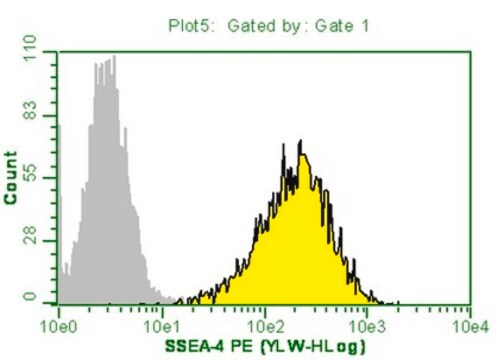FCMAB115F
Anti-TRA-1-60 Antibody, clone TRA-1-60, FITC conjugate
clone TRA-1-60, from mouse, FITC conjugate
About This Item
Prodotti consigliati
Origine biologica
mouse
Livello qualitativo
Coniugato
FITC conjugate
Forma dell’anticorpo
purified antibody
Tipo di anticorpo
primary antibodies
Clone
TRA-1-60, monoclonal
Reattività contro le specie (prevista in base all’omologia)
human (based on 100% sequence homology)
tecniche
flow cytometry: suitable
immunocytochemistry: suitable
Isotipo
IgM
Condizioni di spedizione
wet ice
modifica post-traduzionali bersaglio
unmodified
Informazioni sul gene
human ... PODXL(5420)
Descrizione generale
Specificità
No immunoreactivity is seen with murine EC, EG, or ES cells. Both the TRA-1-60 and TRA-1-81 monoclonal antibodies (MAB4381) recognize antigens that are associated with a pericellular matrix proteoglycan. TRA-1-60 reacts with a sialidase-sensitive epitope whilst TRA-1-81 reacts with an unknown epitope of the same molecule
Immunogeno
Applicazioni
Immunocytochemical staining of live H9 human ES cells incubated for 30 minutes at 37C with 1:100 dilution of anti-TRA-1-60 FITC conjugated (Cat. No. FCMAB115F) monoclonal antibody. Pluripotent human ES cells exhibit strong immunoreactivity to this antibody.
Flow Cytometry:
Antibody dilution for cellular staining:
- Prepare an antibody working solution by diluting 1:5 the primary antibody with PBS.
- Dispense the volume per test of working of solution according to the number of cells indicated in the table below.
- 5 L for Guava Flow Cytometer
- 10 L for other Flow Cytometry instruments
5 μl Working Solution: 5 x 105 Cells / 95 μl PBS. 100 μl Total Reaction Volume
10 μl Working Solution: 1 x 106 Cells / 90 μl PBS. 100 μl Total Reaction Volume
Stem Cell Research
Pluripotent & Early Differentiation
Descrizione del bersaglio
Stato fisico
Stoccaggio e stabilità
Risultati analitici
Pluripotent human embryonic stem (ES) cells
Esclusione di responsabilità
Non trovi il prodotto giusto?
Prova il nostro Motore di ricerca dei prodotti.
Codice della classe di stoccaggio
10 - Combustible liquids
Classe di pericolosità dell'acqua (WGK)
WGK 2
Punto d’infiammabilità (°F)
Not applicable
Punto d’infiammabilità (°C)
Not applicable
Certificati d'analisi (COA)
Cerca il Certificati d'analisi (COA) digitando il numero di lotto/batch corrispondente. I numeri di lotto o di batch sono stampati sull'etichetta dei prodotti dopo la parola ‘Lotto’ o ‘Batch’.
Possiedi già questo prodotto?
I documenti relativi ai prodotti acquistati recentemente sono disponibili nell’Archivio dei documenti.
Il team dei nostri ricercatori vanta grande esperienza in tutte le aree della ricerca quali Life Science, scienza dei materiali, sintesi chimica, cromatografia, discipline analitiche, ecc..
Contatta l'Assistenza Tecnica.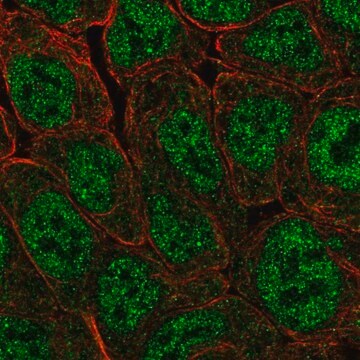
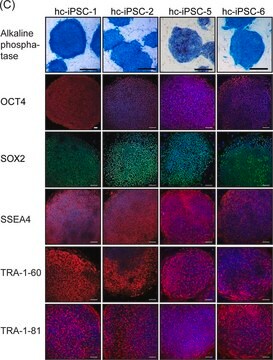
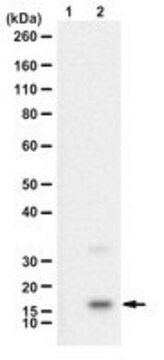
![Anti-OCT-4 [POU5F1] Antibody, clone 7F9.2, Alexa Fluor™ 488 conjugate clone 7F9.2, from mouse, ALEXA FLUOR™ 488](/deepweb/assets/sigmaaldrich/product/images/405/633/324511fc-ecc5-4c49-9d9d-8cf25ab28d40/640/324511fc-ecc5-4c49-9d9d-8cf25ab28d40.jpg)
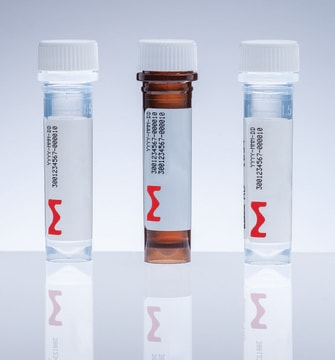
![Anti-OCT-4 [POU5F1] Antibody, clone 7F9.2 clone 7F9.2, from mouse](/deepweb/assets/sigmaaldrich/product/images/307/874/7354f72d-80ee-40a5-b7fa-0590fe6784cc/640/7354f72d-80ee-40a5-b7fa-0590fe6784cc.jpg)
